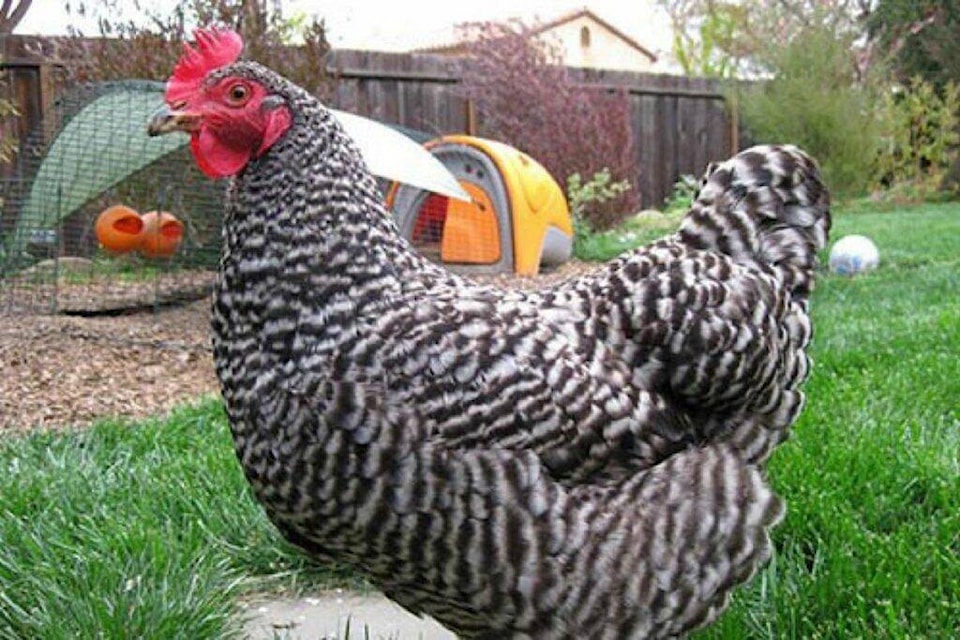Backyard chickens have been on the minds of Fernie residents recently and the potential that they will soon be allowed is generating a lof of discussion.
READ: Fernie Food Action Strategy push for backyard hens
READ; Chicken takeover slow, but hens a hit for one Sparwood resident
Clayton Lamb, PhD, is a wildlife scientist who lives in Jaffray and he shares his thoughts on chickens in bear country.
Chickens are wonderful animals. Laying hens can provide hundreds of eggs a year and endless entertainment—we call it “chicken TV”. Importantly, rearing chickens helps connect people to their food and instill an appreciation for the connection between farm and table. At the same time, the Elk Valley is well outside ideal domestic chicken habitat, burdening chicken owners with the responsibility of protecting their flock and feed from the elements, and from common carnivores, such as bears and foxes. Although raising chickens in grizzly country is doable with significant financial investment in deterrents such as electric fencing, this is no easy feat. The financial benefit of raising one’s own eggs or meat in a Fernie backyard is questionable. It’s more of a hobby. From a bear’s perspective, the abundance of chickens in rural Elk Valley have made for a great snack, although a very costly one since the increase in bears attention toward these birds has led to multiple dead grizzly bears each year, including in 2022 near Fernie.
Food security is a common argument when advocating for keeping backyard chickens and I agree that food security should be bolstered wherever possible. However, to ensure one doesn’t “count their chickens before they hatch” I want to highlight some key points that suggest the backyard chicken food security arguments have been overstated, at least in the Elk Valley.
According to the 2022 Global Food Security Index, Canada places 8th of 113 countries in overall food security, 6th in availability, but 25th in affordability. Thus, while Canada places in the 90th percentile of food security overall, affordability is a concern that everyone is feeling, especially right now in this time of inflation. However, based on my personal experience it is not cheaper to raise eggs at a backyard scale in bear country (~$8/dozen) than to purchase eggs at the store (~$4-8). Depending on the egg source, backyard eggs can be twice the cost.
Another stated benefit of backyard chickens is food availability in the case of unexpected food shortages. Although likely rare and short term, there is precedent: we all remember the empty shelves in March 2020. However, chickens are vulnerable to the impacts of supply chain breakages too. As fewer goods are dispersed, chicken feed could easily be one of them and tough times would likely create fewer kitchen scraps to spare for the hens. A pragmatic, although less entertaining solution to address food security challenges would be to have a healthy stock of non-perishable goods in the pantry, which could reliably support a family during such times. The pantry option also requires less upfront investment than chickens in bear country, which is at least a $1000 start up.
While advocates for backyard chickens suggest risks to bears are low, my experience suggests this assumption need to be re-evaluated. I come to this issue with a unique perspective, having a foot in each world as an electric-fenced chicken owner myself in Jaffray, and a Wildlife Scientist who has studied Elk Valley bears for over a decade. The Elk Valley unfortunately holds the title of BC’s highest rates of grizzly bear conflict and mortality and I have personally investigated the deaths of dozens of bears as the result of interactions with humans. There are numerous attractants that bring bears into the valley such as fruit trees, garbage, and other livestock; but we commonly see chickens attracting bears near settlements in the Elk Valley and multiple bears are killed each year that access poorly secured coops. The best-case scenario for backyard chickens is that electric fencing reduces access to bears, but the risks to both chickens and bears can never be fully eliminated unless e-fences are professionally set up and meticulously maintained. On the heels of record-breaking years for bears killed in town, it’s challenging to make a coherent case for introducing more attractants to an already stressed coexistence landscape.
Concluding as I started, chickens are rad and I hope everyone can enjoy them, but there are legitimate reasons to be skeptical of the food security and bear-safe arguments being made for them. An alternate option would be to mirror a community garden approach where a single electric fence could be erected, and multiple peoples’ chickens could be safeguarded. Centralizing chickens would add some economy of scale to the chicken conundrum, remove the necessity of having a backyard at all—which improves access for everyone—and increase the likelihood that the fence is well maintained and bear safe. A community approach would also provide another opportunity for sharing and gathering. If the new chicken owners are anything like me, talking about chickens is high on the list so there would be no shortage of new connections to be made while collecting eggs. In this set up, discussions about those “dang” grizzly bears ripping apart coops will be less likely too.
